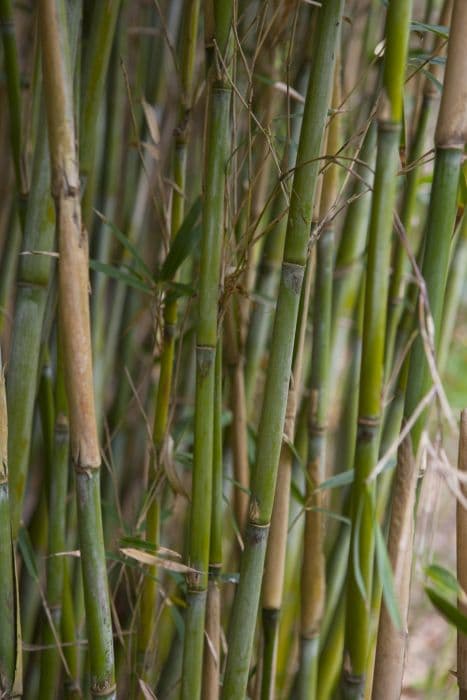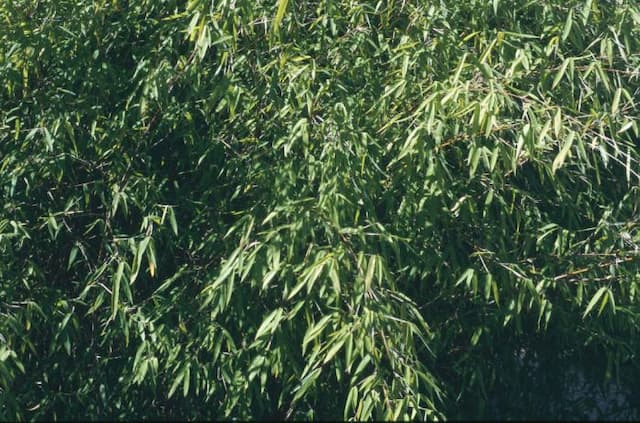Pampas grass 'Splendid Star' Cortaderia selloana 'Splendid Star' (PBR) (v)

ABOUT
'Splendid Star' is a densely tufted, clump-forming, perennial grass, 1.2m high and 1.2m wide, with evergreen, arching, sharply toothed, blue-green leaves striped with yellow, and plume-like panicles of glistening silver-white spikelets, in late summer
About this plant
 Names
NamesFamily
Poaceae
Synonyms
Pampas Grass, Ornamental Grass, Splendid Star Pampas Grass
Common names
Cortaderia selloana 'Splendid Star' (PBR) (v)
 Characteristics
CharacteristicsLife cycle
Perennials
Foliage type
Evergreen
Color of leaves
Variegated
Flower color
Varies
Height
4 feet (1.2 meters)
Spread
3 feet (0.9 meters)
Plant type
Grass
Hardiness zones
7
Native area
South America
Benefits
 General Benefits
General Benefits- Attractive Foliage: The variegated leaves add visual interest to gardens with their striking green and yellow stripes.
- Low Maintenance: Once established, this grass requires minimal care, making it an excellent choice for low-maintenance landscapes.
- Drought Tolerance: It can withstand periods of drought once established, thereby reducing the need for frequent watering.
- Winter Interest: Its foliage and plumes can provide texture and color in the garden even during the colder months.
- Wind Resistance: This robust plant can survive in windy conditions, making it suitable for exposed sites.
- Privacy Screen: When planted in groups, it can act as an informal privacy screen or windbreak.
- Wildlife Habitat: Provides shelter and nesting material for birds and other wildlife.
- Soil Stability: Helps to prevent soil erosion in the landscape due to its robust root system.
- Architectural Aspect: Can be used as a focal point in a garden design due to its distinct and striking appearance.
- Versatility: Suitable for a variety of garden styles, including modern, Mediterranean, or cottage gardens.
 Medical Properties
Medical PropertiesThis plant is not used for medical purposes.
 Air-purifying Qualities
Air-purifying QualitiesThis plant is not specifically known for air purifying qualities.
 Other Uses
Other Uses- Privacy Screens: Pampas Grass can be planted in rows to create natural and aesthetic privacy screens for residential properties or secluded garden areas.
- Sound Barrier: Due to its dense growth, Pampas Grass can help reduce noise pollution in urban gardens, creating a more tranquil outdoor environment.
- Erosion Control: The extensive root system of Pampas Grass makes it useful for stabilizing soil on slopes and preventing erosion in areas susceptible to land degradation.
- Themed Landscaping: Pampas Grass is often used in beach or coastal-themed landscapes to evoke the look and feel of seaside flora.
- Wind Indicator: The tall and flowing plumes of Pampas Grass can serve as a natural wind direction indicator in open spaces like golf courses or airfields.
- Landscape Contrast: Gardeners can utilize the variegated foliage of 'Splendid Star' Pampas Grass to provide contrast against darker-leaved plants, making it a striking feature in garden designs.
- Winter Interest: The plumes and foliage of Pampas Grass remain visually appealing even in winter, providing year-round interest in gardens where many plants are dormant.
- Wildlife Shelter: The dense growth habit provides shelter for small wildlife, such as birds and insects, offering them a safe haven within the landscape.
- Biomass Production: Pampas Grass can be cultivated for biomass purposes, providing an organic material for composting or mulching.
- Craft Material: The dried plumes of Pampas Grass are often used in floral arrangements, wreaths, and other crafts, offering a natural and rustic decorative element.
Interesting Facts
 Feng Shui
Feng ShuiThe Pampas grass is not used in Feng Shui practice.
 Zodiac Sign Compitability
Zodiac Sign CompitabilityThe Pampas grass is not used in astrology practice.
 Plant Symbolism
Plant Symbolism- Beauty: With its striking gold-variegated foliage, the Pampas Grass 'Splendid Star' symbolizes natural beauty and visual appeal, reminiscent of its ornamental use in landscapes and gardens.
- Prosperity: The lush and full growth of Pampas Grass can be symbolic of abundance and prosperity, often reflecting the rich and fertile qualities in nature.
- Resilience: Pampas Grass thrives in various conditions and demonstrates resilience, representing the ability to endure and adapt to life’s challenges.
- Privacy: Often used as a screen in garden settings, Pampas Grass symbolizes our desire for privacy and creating personal spaces.
- Freedom: The tall and free-flowing plumes of Pampas Grass can symbolize a sense of freedom, openness, and the uninhibited flow of ideas or movement.
 Water
WaterPampas Grass requires deep watering once a week, with about 1 to 1.5 gallons for established plants, less for younger plants. During hot and dry spells, you may need to water twice a week. Ensure the soil is well-draining to prevent root rot. In the winter, reduce watering to every other week or when the soil appears dry as Pampas Grass is drought-tolerant and prefers drier soil over the cold months.
 Light
LightPampas Grass thrives in full sunlight, needing at least 6 hours of direct sun per day. The ideal spot for the plant is an open area where it is not overshadowed by trees or buildings, as ample light is crucial for vigorous growth and the development of its characteristic feathery plumes.
 Temperature
TemperaturePampas Grass does well in a wide range of temperatures and is quite hardy, surviving temperatures as low as 20°F and as high as 100°F. However, the ideal temperature for Pampas Grass is between 70°F and 90°F. It is important to note that this grass may not survive prolonged extreme cold without adequate protection.
 Pruning
PruningPruning Pampas Grass is necessary to remove old foliage and make room for new growth. It should be pruned back to about a foot above ground level in late winter before new growth begins. This annual pruning helps in maintaining the size of the plant and encourages healthy, vibrant plumes for the coming season.
 Cleaning
CleaningAs needed
 Soil
SoilPampas Grass thrives in a well-draining, fertile soil with a pH ranging from 6.0 to 7.5. The best soil mix can be created by combining loamy soil with compost and coarse sand to improve drainage and fertility. Regularly adding organic matter will help maintain the soil's richness for optimal growth.
 Repotting
RepottingPampas Grass is a large, often once-planted perennial and does not generally require repotting. It is typically planted outdoors and left to grow without frequent transplanting, so repotting is seldom needed unless to propagate or divide overcrowded clumps every 3 to 5 years.
 Humidity & Misting
Humidity & MistingPampas Grass is quite tolerant of various humidity levels and does not have strict requirements. It does well in average outdoor humidity conditions. It is adaptable and can thrive in both moderately humid and dry climates.
 Suitable locations
Suitable locationsIndoor
Provide full sun, well-draining soil, and infrequent watering.
Outdoor
Plant in full sun, well-draining soil, water deeply but infrequently.
Hardiness zone
7-11 USDA
 Life cycle
Life cycleCortaderia selloana 'Splendid Star', commonly known as Pampas Grass, starts its life as a seed, germinating in warm, well-drained soil with full sun to partial shade exposure. The seedling then develops into a clump-forming grass, with its growth characterized by the emergence of green and gold variegated foliage. As the plant matures, it typically forms a dense tussock of arching leaves that may reach several feet in height. In summer to autumn, Pampas Grass produces tall, feathery plumes that can extend several feet above the foliage, exhibiting cream to silvery-white colors. After the blooming period, the plumes may persist, providing visual interest through the winter months, at which point they may be cut back to encourage fresh growth in the following spring. With a perennial life cycle, Pampas Grass can last for several years, going through repeated seasons of growth, flowering, and dormancy.
 Propogation
PropogationPropogation time
Spring-Early Summer
The most popular method of propagation for Cortaderia selloana 'Splendid Star', commonly known as Pampas Grass, is through division. This is best done in late winter to early spring before the plant begins its active growth phase. To propagate by division, carefully dig up the plant, ensuring to get as much of the root system as possible. The root ball should then be divided into several sections using a sharp spade or knife, making sure each section has at least one growth point. The divisions should then be replanted at the same depth they were growing at originally, spaced about 6 feet (approximately 1.8 meters) apart to allow for ample growth. Water the new divisions well to help establish roots. This method is efficient for maintaining the variegated foliage characteristic of 'Splendid Star' since it is a patented variety and seed production may not produce true-to-type plants.









